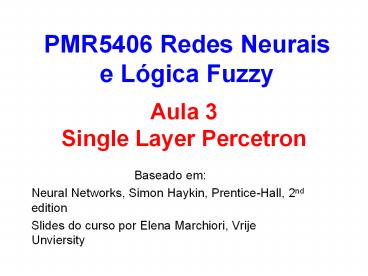Aula 3 Single Layer Percetron - PowerPoint PPT Presentation
1 / 20
Title:
Aula 3 Single Layer Percetron
Description:
PMR5406 Redes Neurais e L gica Fuzzy Aula 3 Single Layer Percetron Baseado em: Neural Networks, Simon Haykin, Prentice-Hall, 2nd edition Slides do curso por Elena ... – PowerPoint PPT presentation
Number of Views:42
Avg rating:3.0/5.0
Title: Aula 3 Single Layer Percetron
1
Aula 3Single Layer Percetron
PMR5406 Redes Neurais e Lógica Fuzzy
- Baseado em
- Neural Networks, Simon Haykin, Prentice-Hall, 2nd
edition - Slides do curso por Elena Marchiori, Vrije
Unviersity
2
Architecture
- We consider the architecture feed-forward NN
with one layer - It is sufficient to study single layer
perceptrons with just one neuron
3
Perceptron Neuron Model
- Uses a non-linear (McCulloch-Pitts) model of
neuron
- ? is the sign function
4
Perceptron Applications
- The perceptron is used for classification
classify correctly a set of examples into one of
the two classes C1, C2 - If the output of the perceptron is 1 then the
input is assigned to class C1 - If the output is -1 then the input is assigned
to C2
5
Perceptron Classification
- The equation below describes a hyperplane in the
input space. This hyperplane is used to separate
the two classes C1 and C2
decision region for C1
x2
w1x1 w2x2 b gt 0
decision boundary
C1
x1
decision region for C2
C2
w1x1 w2x2 b 0
w1x1 w2x2 b lt 0
6
Perceptron Limitations
- The perceptron can only model linearly separable
functions. - The perceptron can be used to model the following
Boolean functions - AND
- OR
- COMPLEMENT
- But it cannot model the XOR. Why?
7
Perceptron Limitations
- The XOR is not linear separable
- It is impossible to separate the classes C1 and
C2 with only one line
8
Perceptron Learning Algorithm
- Variables and parameters
- x(n) input vector
- 1, x1(n), x2(n), , xm(n)T
- w(n) weight vector
- b(n), w1(n), w2(n), , wm(n)T
- b(n) bias
- y(n) actual response
- d(n) desired response
- ? learning rate parameter
9
The fixed-increment learning algorithm
- Initialization set w(0) 0
- Activation activate perceptron by applying input
example (vector x(n) and desired response d(n)) - Compute actual response of perceptron
- y(n) sgnwT(n)x(n)
- Adapt weight vector if d(n) and y(n) are
different then - w(n 1) w(n) ?d(n)-y(n)x(n)
- Continuation increment time step n by 1 and go
to Activation step
10
Example
- Consider a training set C1 ? C2, where
- C1 (1,1), (1, -1), (0, -1) elements of class
1 - C2 (-1,-1), (-1,1), (0,1) elements of class
-1 - Use the perceptron learning algorithm to classify
these examples. - w(0) 1, 0, 0T ? 1
11
Example
12
Convergence of the learning algorithm
- Suppose datasets C1, C2 are linearly separable.
The perceptron convergence algorithm converges
after n0 iterations, with n0 ? nmax on training
set C1 ? C2. - Proof
- suppose x ? C1 ? output 1 and x ? C2 ? output
-1. - For simplicity assume w(1) 0, ? 1.
- Suppose perceptron incorrectly classifies x(1)
x(n) ? C1. Then wT(k) x(k) ? 0. ?
Error correction rule w(2) w(1)
x(1) w(3) w(2) x(2) ? w(n1) x(1)
x(n)
w(n1) w(n) x(n).
13
Convergence theorem (proof)
- Let w0 be such that w0T x(n) gt 0 ? x(n) ? C1.
w0 exists because C1 and C2 are
linearly separable. - Let ? min w0T x(n) x(n) ? C1.
- Then w0T w(n1) w0T x(1) w0T x(n) ? n?
- Cauchy-Schwarz inequality w02
w(n1)2 ? w0T w(n1)2 - w(n1)2 ? (A)
n2 ? 2 w0 2
14
Convergence theorem (proof)
- Now we consider another route w(k1) w(k)
x(k) w(k1)2 w(k)2
x(k)2 2 w T(k)x(k) euclidean
norm ????? ? 0 because x(k) is
misclassified - ? w(k1)2 ? w(k)2 x(k)2
k1,..,n - 0
- w(2)2 ? w(1)2 x(1)2
- w(3)2 ? w(2)2 x(2)2
- ? w(n1)2 ?
15
convergence theorem (proof)
- Let ? max x(n)2 x(n) ? C1
- w(n1)2 ? n ? (B)
- For sufficiently large values of k
(B) becomes in conflict with (A).
Then n cannot be greater than nmax such that (A)
and (B) are both satisfied with the equality
sign. - Perceptron convergence algorithm terminates in at
most nmax iterations.
? w02 ?2
16
Adaline Adaptive Linear Element
- The output y is a linear combination o x
17
Adaline Adaptive Linear Element
- Adaline uses a linear neuron model and the
Least-Mean-Square (LMS) learning algorithm - The idea try to minimize the square error, which
is a function of the weights - We can find the minimum of the error function E
by means of the Steepest descent method
18
Steepest Descent Method
- start with an arbitrary point
- find a direction in which E is decreasing most
rapidly - make a small step in that direction
19
Least-Mean-Square algorithm (Widrow-Hoff
algorithm)
- Approximation of gradient(E)
- Update rule for the weights becomes
20
Summary of LMS algorithm
- Training sample input signal vector x(n)
- desired response d(n)
- User selected parameter ? gt0
- Initialization set w(1) 0
- Computation for n 1, 2, compute
- e(n) d(n) - wT(n)x(n)
- w(n1) w(n) ? x(n)e(n)































